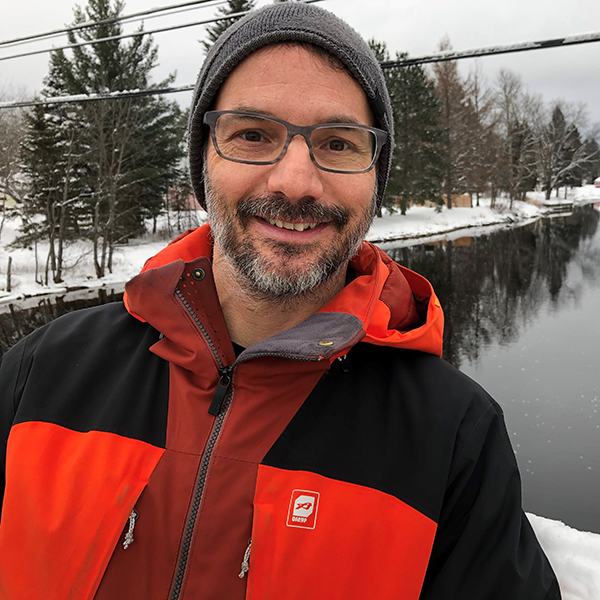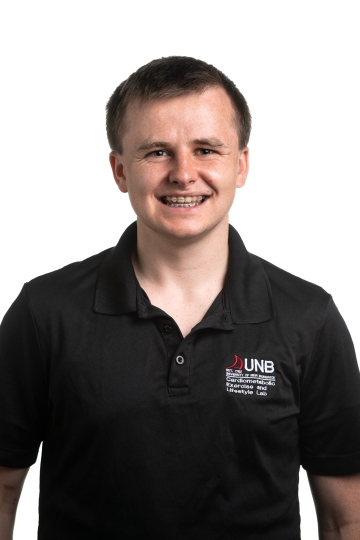Jean Paquin
Water Resources Analyst Engineer at Rio Tinto
Rio Tinto
Learn About My Career
Jean Paquin is a Water Resources Analyst Engineer at Rio Tinto.
I was born/grew up in: in Rouyn-Noranda in Abitibi-Temiscamingue, a region in northwestern Quebec.
I now live in: in the city of Saguenay (Chicoutimi) in Quebec
I completed my training/education at: College studies: Cégep de l’Abitibi-Témiscamingue in Pure and Applied Sciences
University Bachelor’s degree: Université de Sherbrooke in Civil Engineering
Master’s degree in Applied Sciences: Université de Sherbrooke, civil engineering, subject in urban hydraulics
In my work, I analyze, calculate, and make decisions on water flow to be discharged at production sites. Then I communicate these decisions so they can be applied. I keep track of the changes in the weather situation.
In Quebec, water is the driving force behind the entire aluminum industry. The potential energy of water is transformed into electrical energy. This happens via a hydroelectric production system which is made up of reservoirs and power plants. The average energy produced by Rio Tinto in Quebec is 2100 MW/year. This is enough energy to power 1 million homes for a whole year in Quebec. To generate that much electricity, it takes a lot of water. The territory that collects rainwater has a surface area of 73,800 square km. This is more than 150 times the size of the island of Montreal. The reservoirs that store the water have a volume of 3.5 million Olympic-sized swimming pools.
Managing natural water inflows in such a territory is quite a challenge. There is always a random element associated with the very nature of the raw material, water. Good mathematical and computer skills are assets.
It is also important to be flexible, to be able to adapt and make decisions quickly. This is especially important in times of extreme rainfall. It is also important to be able to communicate your ideas well in both French and English.
An engineering background allows us to develop a toolbox to solve complex problems. I analyze observed precipitation and I combine it with weather forecasts. I make forecasts using a hydrological model. This is a bit like a video game that represents the territory, the behaviour of rivers, and natural water supplies. Then, I simulate these inputs in these complex models. I then decide how to get the best value from the water.
To do this, I assess several constraints and big issues. These include such things as security of supplies and dam safety. It also includes understanding the operating levels in the plants. To make these decisions, models are necessary. However, it is human analytical common sense that decides changes in operation.
When I finished CEGEP in science, I knew I wanted to go to university to study science. At that time, I was mostly interested in volleyball and girls. When I applied to university, I looked at the options and a career in engineering was obvious… but which one? Looking through the various programs, a description of civil engineering caught my attention. It talked about the design of large pipelines, water flow…that’s all it took. I did my first years at the Université de Sherbrooke in civil engineering. This program had a co-op program with internships. I had a lot of fun learning mathematics, materials science, structures. It wasn’t until around the third year, that I remembered why I had chosen this program. At that time I took my first hydraulics courses in the program. That’s when my passion was awakened and I knew it was the right choice for me.
At the end of my bachelor’s degree, I decided to pursue a master’s degree with a specialization in hydraulics. Afterwards, my career plan was to work in this field. I had a short stay in an engineering firm where there was not enough hydraulics to my liking. After this, I was able to work for Rio Tinto in the operation of a large-scale water system. This is where I am today!
I love nature and lakes. Being able to combine a technical career in engineering with this passion is a dream job for me. Of course, most of my work is done on a computer, but field trips are always very much appreciated. Contributing to the production of clean and renewable energy is a source of pride for me.
What I appreciate most about my work is that you don’t see time go by! After almost 20 years in this career, I am still excited to get to work in the morning. I still almost run to get back so I can continue the work (model or analysis) that I had to leave the day before. Since nature is what shapes my work, it is very variable. You must be very flexible and able to adapt quickly.
Teamwork is also important in my job. Companionship, knowledge sharing and interaction during difficult decisions are the keys to success and fun at work.
Another interesting element in my work is task diversity. Being involved in the collection of data that will be used in operational decisions is great.
My work can have a large negative impact if it is not done well. For example, if there is too much water we need to open the spillways. If this is not done soon enough, it can lead to flooding or even dam failure. This risks the safety of nearby populations. On the other hand, if water shortages are not anticipated, this can lead to the closure of several aluminum processing plants. This would result in large monetary and job losses. So yes, my work has a significant influence on the lives of others. But, I prefer to stay in the shadows and operate the system as safely as possible. When people don’t talk about us, it’s a sign that all is well!
For fun, I play outside with my three boys! I like to go sliding and take walks in the forest. In the winter, we also go downhill skiing with the family. In the summer, it’s swimming and biking. I especially like swimming in Lac Saint-Jean…it’s so well managed!
A tip would be to make sure you have fun while learning or working. For learning that you enjoy less, look at it not as an end in itself, but as an exercise of the mind; a bit like brain “push-ups”. This will improve your problem-solving skills, whatever they may be.
What I do at work
In my work, I analyze, calculate, and make decisions on water flow to be discharged at production sites. Then I communicate these decisions so they can be applied. I keep track of the changes in the weather situation.
In Quebec, water is the driving force behind the entire aluminum industry. The potential energy of water is transformed into electrical energy. This happens via a hydroelectric production system which is made up of reservoirs and power plants. The average energy produced by Rio Tinto in Quebec is 2100 MW/year. This is enough energy to power 1 million homes for a whole year in Quebec. To generate that much electricity, it takes a lot of water. The territory that collects rainwater has a surface area of 73,800 square km. This is more than 150 times the size of the island of Montreal. The reservoirs that store the water have a volume of 3.5 million Olympic-sized swimming pools.
Managing natural water inflows in such a territory is quite a challenge. There is always a random element associated with the very nature of the raw material, water. Good mathematical and computer skills are assets.
It is also important to be flexible, to be able to adapt and make decisions quickly. This is especially important in times of extreme rainfall. It is also important to be able to communicate your ideas well in both French and English.
An engineering background allows us to develop a toolbox to solve complex problems. I analyze observed precipitation and I combine it with weather forecasts. I make forecasts using a hydrological model. This is a bit like a video game that represents the territory, the behaviour of rivers, and natural water supplies. Then, I simulate these inputs in these complex models. I then decide how to get the best value from the water.
To do this, I assess several constraints and big issues. These include such things as security of supplies and dam safety. It also includes understanding the operating levels in the plants. To make these decisions, models are necessary. However, it is human analytical common sense that decides changes in operation.
My career path is
When I finished CEGEP in science, I knew I wanted to go to university to study science. At that time, I was mostly interested in volleyball and girls. When I applied to university, I looked at the options and a career in engineering was obvious… but which one? Looking through the various programs, a description of civil engineering caught my attention. It talked about the design of large pipelines, water flow…that’s all it took. I did my first years at the Université de Sherbrooke in civil engineering. This program had a co-op program with internships. I had a lot of fun learning mathematics, materials science, structures. It wasn’t until around the third year, that I remembered why I had chosen this program. At that time I took my first hydraulics courses in the program. That’s when my passion was awakened and I knew it was the right choice for me.
At the end of my bachelor’s degree, I decided to pursue a master’s degree with a specialization in hydraulics. Afterwards, my career plan was to work in this field. I had a short stay in an engineering firm where there was not enough hydraulics to my liking. After this, I was able to work for Rio Tinto in the operation of a large-scale water system. This is where I am today!
I am motivated by
I love nature and lakes. Being able to combine a technical career in engineering with this passion is a dream job for me. Of course, most of my work is done on a computer, but field trips are always very much appreciated. Contributing to the production of clean and renewable energy is a source of pride for me.
What I appreciate most about my work is that you don’t see time go by! After almost 20 years in this career, I am still excited to get to work in the morning. I still almost run to get back so I can continue the work (model or analysis) that I had to leave the day before. Since nature is what shapes my work, it is very variable. You must be very flexible and able to adapt quickly.
Teamwork is also important in my job. Companionship, knowledge sharing and interaction during difficult decisions are the keys to success and fun at work.
Another interesting element in my work is task diversity. Being involved in the collection of data that will be used in operational decisions is great.
How I affect peoples’ lives
My work can have a large negative impact if it is not done well. For example, if there is too much water we need to open the spillways. If this is not done soon enough, it can lead to flooding or even dam failure. This risks the safety of nearby populations. On the other hand, if water shortages are not anticipated, this can lead to the closure of several aluminum processing plants. This would result in large monetary and job losses. So yes, my work has a significant influence on the lives of others. But, I prefer to stay in the shadows and operate the system as safely as possible. When people don’t talk about us, it’s a sign that all is well!
Outside of work I
For fun, I play outside with my three boys! I like to go sliding and take walks in the forest. In the winter, we also go downhill skiing with the family. In the summer, it’s swimming and biking. I especially like swimming in Lac Saint-Jean…it’s so well managed!
My advice to others
A tip would be to make sure you have fun while learning or working. For learning that you enjoy less, look at it not as an end in itself, but as an exercise of the mind; a bit like brain “push-ups”. This will improve your problem-solving skills, whatever they may be.
A water resources analyst engineer at RioTinto is a professional who manages and optimizes water resources over a vast territory for hydroelectric production purposes. The natural water cycle brings its share of challenges in terms of dam safety, respect for the needs of users (residents) and the reliable and continuous supply of an industrial process, that of aluminum transformation.
When I was a student I enjoyed:
- Geography
- History
- Math
- Physical Education/Health
- Science
- Technology
When I was a student, I would describe myself as someone who:
- Enjoyed doing things on my own
- Liked helping people
- Played on a sports team
- Was motivated by success
- Liked being given free range to explore my ideas
- Felt great satisfaction in getting good grades
- Had confidence on what the future would bring
Partners
Related Topics
Explore More Career Profiles
-
Brianna Lummerding
Career Profiles
Agronomic Innovation Manager
I look after all things related to soil management for a group of retailers. -
Li Tan (he/him)
Career Profiles
Molecular Lead
I coordinate the day-to-day operations in the DNA Extraction Lab. -
Tyler Morhart (video)
Career Profiles
Scientist, Beamline Responsible - SyLMAND
I am responsible for the SyLMAND beamline at the Canadian Light Source synchrotron facility. -
Li Tan (Video)
Career Profiles
Molecular Lead
I coordinate the day-to-day operations in the DNA Extraction Lab. -

Rashell Featherstone (she/her)
Career Profiles
Senior Program Associate
I coordinate projects for the development of new products at STEMCELL. -
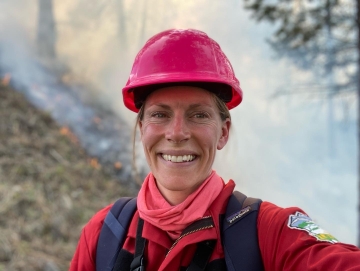
Kira Hoffman (she/her)
Career Profiles
Postdoctoral Researcher/Fire Ecologist
I am a researcher at both a university and a not-for profit organization where I am gaining experience to become a senior researcher. -
Zoë Ehlert (Video)
Career Profiles
Manager, Marker Assisted Breeding
I lead a team that develops canola crops by breeding plants with traits we are looking for. -
Zoë Ehlert
Career Profiles
Manager, Marker Assisted Breeding
I lead a team that develops canola crops by breeding plants with traits we are looking for. -
Jennifer Baltzer (she/her)
Career Profiles
Professor and Canada Research Chair in Forests and Global Change
I work at a university, teaching students and conducting research on the impact of climate change on forests in Canada and around the world. -
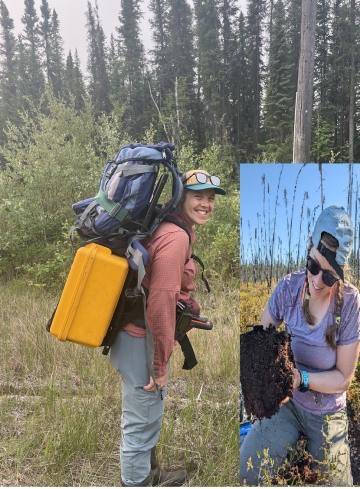
Caitlyn Lyons (she/her)
Career Profiles
Ph.D. Candidate
I am working towards my PhD and studying the forests in the Northwest Territories. -
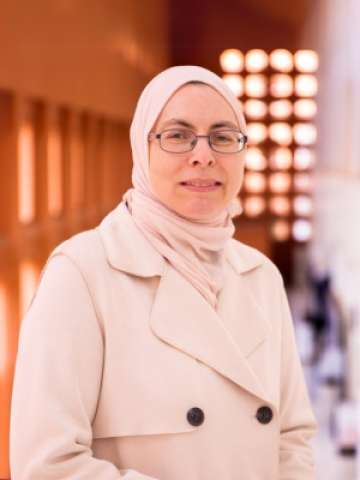
Joann Whalen
Career Profiles
Professor at the Faculty of Agricultural and Environmental Sciences,
I teach advanced courses on how to manage soils to produce healthy, nutritious food and maintain healthy ecosystem functions.
